A hike through Jester Park yielded golden oyster mushrooms.
Writer: Macey Shofroth
Photographer: Joe Crimmings
As you drive north on Highway 141, the suburban homes begin to give way to the thick, verdant brush of Jester Park near Granger.
The 1,600 acres in northwestern Polk County epitomize nature’s paradise — stretches of forests, fields of prairie dotted with gold and ponds teeming with aquatic life. It’s quiet, save for chirping robins or a family hiking on one of the park’s many trails.
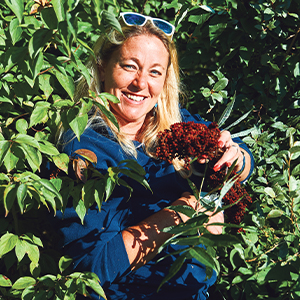
An average visitor may not realize that within this abundant expanse of Iowa habitat lies the potential for an entire feast. Only if you know where and how to look.
Missy Smith, who leads the Jester Park Nature Center for Polk County Conservation, and Derek Eidson, the executive chef at Django and the newly opened Guesthouse Tavern + Oyster, recently discovered the culinary opportunity at their fingertips when they teamed up to host a fundraising dinner of ingredients foraged from Jester Park. As they learned more about foraging in Iowa, a tradition with deep Indigenous roots, they developed a fascination about the land and how it can nourish us — as long as it’s nourished in return.
Planting the seeds
Smith reached out to Eidson last year about cooking a dinner to raise money for the injured owls that Polk County Conservation cares for at the park in Granger, on the northwest corner of Greater Des Moines.
“We wanted to forage as much as possible from Jester Park, have the dinner at Jester Park and cook the majority of the food over a live fire from trees that had fallen at Jester Park,” Eidson said. The question became: “How much can we get from right here?”
The answer: A lot.

Eidson’s interest in foraging started through friends and years of cooking in some of the city’s best restaurants, including Centro and Lucca. Smith has worked as a naturalist for nearly 20 years. As the pair researched Iowa’s natural edibles and their flavor profiles, they kept venturing further along the proverbial path.
“That first year, I was learning as we went,” Smith said. “Then I kind of caught the bug and started taking some classes by other naturalists.”
These days, Smith has her hidden spots where she knows she’ll find gold. Eidson gives her a list of the ingredients he’s looking for — walnuts, ramps, wild grapes, mountain mint and the like — and she heads out to find them.
She often discovers them around the park. Other times, she’ll find the plants where most wouldn’t think to look. Once, she harvested pineapple weed, also known as wild chamomile, from her neighbor’s gravel driveway.
Growing with care
In many Indigenous cultures, the relationship between humans and Earth is one of kinship. Earth is understood as our Mother, and each life she produces is part of us, too. Taking from her recklessly as we’ve often done, harming our relatives, destroys the balance of the relationship.
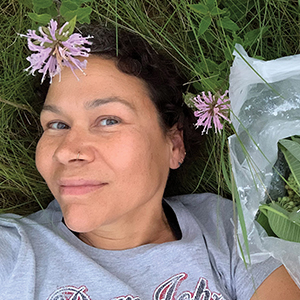
That’s why some Indigenous women practice rematriation, the process of rebalancing that relationship and restoring sacred connections with the land, according to Shelley Buffalo, a Meskwaki Nation tribal member and rematriation consultant with the Great Plains Action Society.
Foraging is one way to reestablish that relationship with the land. Since it requires careful observation, foragers often develop a deep respect for the natural world.
It’s legal to forage fruits, nuts, berries and mushrooms in Polk County parks, but true foragers follow the unwritten rule: Never take more than what you need. Sustainability matters. Besides, birds need those berries more than we do.
“Always harvest less than 20% of what is available on any particular plant to avoid overharvesting an area,” Smith said.
Buffalo often hears about foragers, especially new ones, who harvest too much. Their excitement about finding their own food leads them to make detrimental choices.
“If foragers dig up everything, how is that species going to bounce back and reproduce itself?” Buffalo said. “If you actually care and want these ecologies to thrive and bounce back, you should do it with respect and love.”
Common etiquette forbids foragers from disturbing or harming the habitat. Bee balm, for example, is a native prairie plant necessary for pollinators. As part of her work with Polk County Conservation, Smith harvests it from areas around the nature center’s parking lot because it can overtake other plants if it grows outside of a prairie.
Wild ramps, which are similar to leeks, can be foraged only on private land. Cattails are often foraged from ponds to keep them from taking over; when they’re pickled, they taste like cucumbers.
Being able to walk into the woods and find things that are edible “is the best thing for a chef, or anybody interested in food,” Eidson said, but with Iowa’s weather, it’s never quite that simple. Foraging is about timing, knowing when certain plants are ripe and ready to render the flavors foodies imagine all year. Some harvest seasons are short, and volatile, like Iowa’s stormy spring.
“A lot of the area I harvested was underwater this year,” Smith said. “The weather’s been good for mushrooms this year, and I would assume it’ll be good for nuts, except for high wind situations. Foraging makes you more aware of how everything changes.”
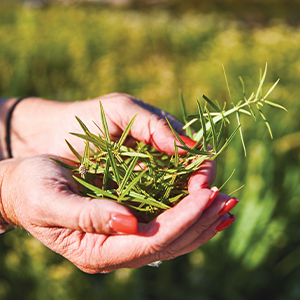
A handful of mountain mint found at Jester Park, which flourishes even on the Iowa prairie.
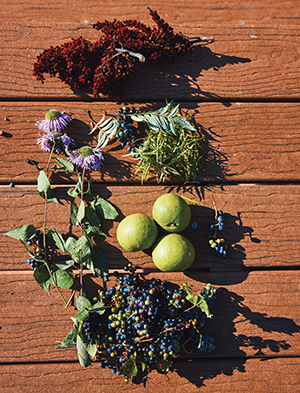
Clockwise from top: sumac, mountain mint, walnuts, wild grapes and flowering bee balm (wild bergamot), all foraged this summer at Jester Park.
Enjoying the harvest
Foraging connects Smith, Eidson and others to a bigger narrative around food. Finding ingredients within the parameters Earth has set, finding different uses for them, finding ways to keep them until you need them — it’s all a throwback to how our ancestors used to eat.
That’s a narrative Buffalo hopes humans can continue to rewrite. She explained the Indigenous relationship to the land as spiritual, scientific and metaphysical. She wants others to understand our obligation to Earth.
“What disrupts this balance is the concept of profit: ‘I’m going to take more because I want to and I need to make money,’” she said. “This isn’t just food. It’s medicine. And food is medicine.”
Learning about plants’ medicinal properties has helped Smith and Eidson understand the possibilities lying in Iowa’s nature. Stinging nettles, for example, have tiny “teeth” that poke and irritate the skin when they’re handled, but steeping the leaves destroys the teeth and removes the sting.
“They’re amazing for allergies,” Smith said. “I’ll make tea out of them, and then I don’t need to take allergy medicine anymore.”
Her family has gotten into foraging, too. She took her mom with her to a foraging class, and her kids enjoy hunting mushrooms. Her husband is a park ranger in Story County and occasionally brings home new ingredients from the woods.
“He found some wild plums, which we didn’t need for the dinner, so I said, ‘Let’s see what we can make with those,’” Smith said. “My family has become my guinea pigs.”
Both Smith and Eidson have developed a deeper love for the Iowa land since they began foraging. It can be a catalyst to change relationships Iowans have with their land, to help people deepen their understanding of and appreciation for the diversity of life that surrounds us.
Smith has experienced this firsthand.
“I’ve been a naturalist for nearly 20 years now. I’ve always looked for birds because I’m a huge birder,” she said. “Now, when I’m walking I look down. I’ve trained myself to look for different things. It changes your perspective.”
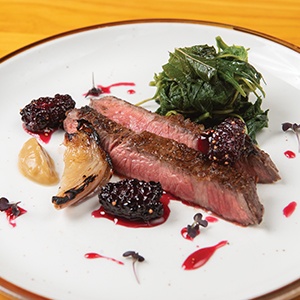
A ribeye dish with foraged amaranth and blackberries, created by chef Derek Eidson.









